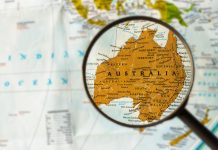
Australia probably won’t be as challenging as studying abroad in a developing country with a different language and no running water, but that doesn’t mean it’s easy. And if you don’t do your research, you may find yourself in a bind or facing some difficult surprises once you’re abroad. To study in Australia for more than three months, you will need a visa. The process of applying is fairly easy. It’s all done online and it is virtually linked to your passport — no embassy visits or waiting for it to arrive in the mail. However, the fee is expensive, so be prepared! If you study for less than three months, you should be able to go on a regular tourist visa and save yourself some moolah. Make sure to research this. If you are going on a study abroad program, it may be included, but if you are studying directly with a university, chances are you’ll be required to get health insurance in Australia.
Often, getting travelers insurance through a company like World Nomads will give you the same security, and, less often, the health insurance plan you’re already on my work overseas. Be sure to do your research before shelling out money for some travelers/health insurance. There are a lot of different kinds of places in Australia for you to choose from on your study abroad trip. Certain areas may be better for you depending on what you study. If you’re a marine biology major, then somewhere further north near the Great Barrier Reef might be better (GlobaLinks has a program for marine biology students in Perth that includes research in the Great Barrier Reef, actually). If you’re a business major, maybe studying abroad in Sydney might be a better fit.
The time difference between Australia and the Americas is intense. If you arrive in the morning, force yourself to stay up all day. If you arrive at night, go to bed. The sooner you dive into your new time zone, the better.
After that initial jet lag is over though, you’ll then be faced with the complicated issue of finding a good time to talk to your friends and family back home! Just make sure when you suggest a time for a Skype date, you include the time/date in both your and their time zones to avoid confusion!
Sydney and Melbourne regularly make the top ten lists of the world’s most expensive cities. From housing to groceries, prepare to experience some sticker shock and make sure to have a good chunk of change saved.
Agriculture and can be defined as the cultivation of land and breeding of animals and plants to provide food, fibers, medicinal plants, and other products to sustain and enhance life. It has been credited as one of the main contributors to the rise of sedentary human civilization, wherein people settle in one area for longer periods. Agriculture dates back thousands of years. The field of agricultural science is fast developing and is having large ecological and Agriculture and Environmental effects. A degree in Agriculture and Environmental will allow you to understand the scientific, logistical and env, environmental aspects of crop and animal production. Studying agriculture will likely include a large proportion of scientific modules such as biochemistry, natural/environmental science,s, and biology. You may also be required to study some business models as well, such as mathematics, humanities, es, and economics. These will give you a well-rounded insight into the ethics and science of the agricultural industry. The degree may be taught in a mixture of modes. These will likely include classroom-based work, laboratory work, and practical based work. This practical work may be undertaken on campus, or you may be encouraged to participate in a work placement to gain relevant experience. Gain an integrated and multidisciplinary understanding of agricultural science, and the social, political, and economic drivers of resource management, Agriculture and Environmental development an,d sustainability. You’ll also develop a sound understanding of the structure and operation of the agricultural production industries of Australia, as well as an understanding of Australia’s role in global food fiber production. The degree requires the successful completion of 300 points – with subjects usually worth 12.5 points each. You will complete eight subjects, or 100 points of study, in each year of full-time study. In the first year, you will complete eight core subjects, gaining a solid foundation in agricultural science with studies in biology, natural environments, agricultural production,n, and life sciences. In the n second year, you will become familiar with the field of agriculture. You will begin working towards a major by selecting electives that align with your interests and serve as prerequisites for major subjects. You will also be able to spend a semester learning at our Dookie campus. In the third, if one is selected major along with the course, capstone subject consolidates your studies and will equip you with knowledge, skills, ls, and aptitudes required to assess and improve performance in agricultural industries, to ensure long term sustainability, and to contribute as a leader in Agriculture and Environmental industries and communities. With important input from industry experts and potential employers, our curriculum focuses on developing graduate agricultural scientists job ready from day one. The agricultural boom places agricultural science graduates in a position of high demand. Around 90 percent of graduates gain full-time employment four months after graduation, 12-15 percent higher than the average of all bachelor’s degrees. Positions are available in both cities and rural areas. A range of interesting and diverse careers will be available to you, as well as graduate study options and research in food science, agribusiness, the agricultural sciences, and a range of other fields. If you have completed the Production Animal Science major and have achieved high average marks, you can even apply to study the Doctor of Veterinary Medicine with up to 30 points credit in the first year.
In many ways, Australia is a world leader on earth and Agriculture and Environmental issues. It was in Sydney that the first-ever Earth Hour was held, in 2007, and the country also plays a strong role in other global environmental events, such as the annual World Environment Day. This general trend is also reflected in Australia’s universities, which have a strong presence in the most recent QS rankings for both earth sciences and environmental science. Australia’s highest-ranking institution in both subjects is Australian National University (ANU), which is also the country’s highest-ranked university overall – ranked 26th in the world in the QS World University Rankings 2011/12. In the 2012 ranking for earth sciences, ANU has climbed from ninth to joint eighth. This makes it the only university from outside the US and UK in the earth sciences top ten.
Similarly, in environmental sciences, ANU climbs one place, from tenth to ninth. In this case, there is a little more regional diversity; ANU sits between Switzerland’s ETH Zurich and Canada’s University of Toronto. Other Australian universities with strengths in the earth and environmental sciences include the University of Queensland, University of Melbourne, University of Sydney, and Macquarie University. In total, Australia has 12 universities in the global top 200 for earth sciences, and 13 for environmental sciences.
While the subject rankings are a good starting point, there is of course more to choosing a degree course than just picking a selection of highest-ranked universities. Dr. Joerg Hermann, a research fellow at ANU’s Research School of Earth Sciences, advises prospective students to check out the structure of the degree, the range of topics available to study, and how much practical work is included in the course. Professor Stephen Dovers, director of ANU’s Fenner School of Environment and Society, echoes these points, urging students to make sure they choose a course that matches their interests. He adds that a degree of flexibility is an advantage, as this allows for the fact that students’ interests will evolve as they study. Other factors to consider include the size of classes, amount of contact time, quantity and quality of field trips, and the university’s research activity – especially if the institution has a policy of incorporating new findings into teaching straight away. Environmental science is a lot of fun, and not that difficult, provided you are good with science such as geology, chemistry, and biology. The hardest part of Agriculture and Environmental science isn’t the degree. The hardest part is working in the field. Environmental Science is an unusual academic discipline in that it requires scientific knowledge about the natural world, as well as an understanding of abo fays in which humans interact with the natural world Core courses in the Environmental Science major, include biology, chemistry, geology, and mathematics. The field of environmental science can be divided into three main goals, which are to learn how the natural world works, to understand how we as humans interact with the environment, and also to determine how we affect the environment.
Dr. Rex N. Olinares, a professor emeritus at the University of the Philippines, is considered to be the “father of Agriculture and Environmental Science.” He proposed that sanitation and hygienic measures are necessary to prevent the spread of microorganisms. he also proposes that sanitation is the root cause of environmental pollution.
The field of environmental science can be divided into three main goals, which are to learn how the natural world works, to understand how we as humans interact with the environment, and also to determine how we affect the Agriculture and Environmental.
















































